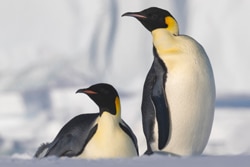We at PONANT offer the most epic small ship polar expeditions on earth. But there’s another epic journey that unfolds in the white wilderness of Antarctica—the migration of the emperor penguin. Our voyage aboard Le Commandant Charcot into the farthest reaches of the southern continent helps you have a glimpse on the daily drama of this most imperial of penguins.
When you first lay eyes on the gleaming-white shores of Antarctica, the first thing you’re likely to feel is an overwhelming sense of reverence and awe. The beauty is ethereal here, the grandeur unrivalled. Upon seeing its hulking ice shelves, 19th-century explorers called it Terra Australis Incognita, or the “unknown land of the south,” and much of its mystery endures. To help you unravel its secrets, Ponant gives you unrivalled access from our luxury Antarctic expedition ship Le Commandant Charcot. On board, extravagant accommodations, the most eco-conscious technology in the industry, and onboard scientific inquiry combine to show you a fascinating side of the white continent that other travelers miss.
It all seems utterly uninhabitable, this frozen continent. But Antarctica is home to a profusion of marine and bird life, from leopard seals to humpback whales. And there’s one resident whose reputation for endurance amidst the planet’s harshest weather conditions precedes it: the magnificent emperor penguin. Standing among a chirping rookery is one of life’s truly astonishing moments. During our Antarctic cruise, Ponant brings you as close as possible to these remarkable creatures.
The Emperor’s Arduous Icy Journey to Parenthood
We bring you to Antarctica during the height of the Antarctic summer, November through March, when temperatures can climb into the Fahrenheit 30s and 40s. This is the time when emperor penguins feed on krill, silverfish, and squid in the icy ocean and linger near shore. But this is not their primary habitat. Their other home—their breeding ground—may be up to 75 miles away on a distant icy expanse. They gorge on the ocean’s bounty here so that they’ll have an energy reserve to get them there, one waddling mile at a time. As days grow shorter in March or April the great inland migration begins. A colony may walk for weeks, often in harsh conditions and over rugged landscapes. By the time they settle in to their breeding grounds, temperatures may have plummeted to as low as -40˚F.
The courtship between male and female is brief and culminates in May or June with one egg. It’s mom’s job to lay it; it’s dad’s job to incubate it. The shell is thick, reducing the risk that it will crack or break and providing some insulation from the bitter cold. It’s a delicate act for the female to transfer the egg to the male and it’s not unusual for the couple to drop it. If it cracks, the chick is lost to the cold in as little as one minute. The male incubates the egg by balancing it atop its feet and hugging it in the warm folds of his skin.
Mom Takes Maternity Leave, Emperor Style
Depleted of the food reserves that she’s tapped into since her ravenous days at sea, the mother retraces her trek to the coast, leaving the father to incubate the egg for up to ten weeks in the dark, stormy Antarctic winter where winds can roar up to 120 miles per hour. Only emperor penguins leave incubation solely to the male; in all other species, the female shares the responsibility.
By the time the hatchling emerges, the male hasn’t eaten for about 120 days and lost more than half its body weight – shrinking on average from 84 to 40 pounds. As for mom, her return to the colony is remarkably well-timed. Within ten days after the egg hatches, she arrives with partially digested food for her chick, locating her mate by his distinctive calls among a colony of hundreds. Parents then take shifts. After many weeks of fasting, it’s dad’s turn to return to sea for a well-deserved banquet.

PONANT CITIZEN SCIENCE FACT:
The monogamous emperor penguin is a product of human imagination. In fact, the emperor is serially monogamous, staying with the same mate for only a year. Scientists believe the reason for this is purely logistical from an evolutionary perspective: There’s such a slim window in which the bird can mate that neither the male nor the female waits for last year’s partner to return to the colony.
Come face to face with the emperor penguin when you join a luxury Antarctic expedition aboard Le Commandant Charcot.